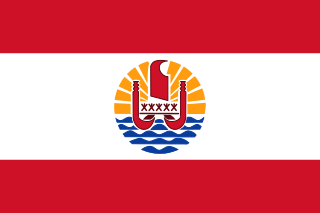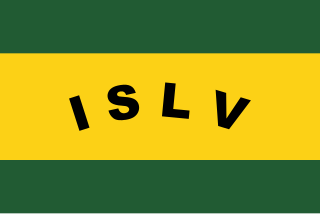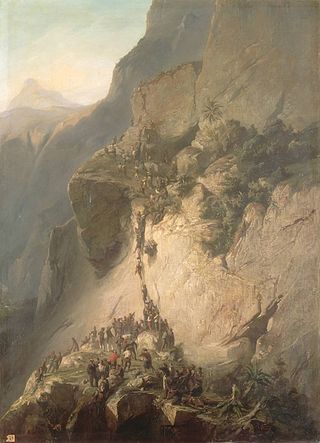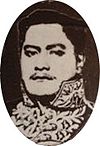
French Polynesia is an overseas collectivity of France and its sole overseas country. It comprises 121 geographically dispersed islands and atolls stretching over more than 2,000 kilometres (1,200 mi) in the South Pacific Ocean. The total land area of French Polynesia is 3,521 square kilometres (1,359 sq mi), with a population of 278,786.

Bora Bora is an island group in the Leeward Islands. The Leeward Islands comprise the western part of the Society Islands of French Polynesia, which is an overseas collectivity of the French Republic in the Pacific Ocean. Bora Bora has a total land area of 30.55 km2 (12 sq mi). The main island, located about 230 kilometres northwest of Papeete, is surrounded by a lagoon and a barrier reef. In the center of the island are the remnants of an extinct volcano, rising to two peaks, Mount Pahia and Mount Otemanu; the highest point is at 727 m (2,385 ft). Bora Bora is part of the Commune of Bora-Bora, which also includes the atoll of Tūpai. The languages spoken in Bora Bora are Tahitian and French. However, due to the high tourism population, many natives of Bora Bora have learned to speak English.

Raiatea or Ra'iatea is the second largest of the Society Islands, after Tahiti, in French Polynesia. The island is widely regarded as the "centre" of the eastern islands in ancient Polynesia and it is likely that they organised migrations to the Hawaiian Islands, New Zealand and other parts of East Polynesia started at Ra'iātea.

Ari'i-ʻOtare Teriʻi-maeva-rua III Pomare was the last Queen of the Tahitian island of Bora Bora from 1873 to 1895.
Air Tahiti is a French airline company which operates in French Polynesia. Its main hub is Faa'a International Airport. It is the largest private employer in French Polynesia.

The Leeward Islands are the western part of the Society Islands in French Polynesia, an overseas collectivity of France in the South Pacific. They lie south of the Line Islands, east of the Cooks and north of the Austral Islands. Their area is 404 km2 and their population is over 36,000.

The Society Islands are an archipelago in the South Pacific Ocean. Politically, they are part of French Polynesia, an overseas country of the French Republic. Geographically, they form part of Polynesia.

Gaston Tong Sang is a French Polynesian politician and is the former President of French Polynesia. He served terms as President of French Polynesia from November 2009 until April 2011, from April 2008 until February 2009 and from December 2006 until September 2007; he is currently the Mayor of Bora-Bora. He is of Chinese descent, and is a founding member of French Polynesia's pro-French Tahoera'a Huiraatira political party.

The president of French Polynesia has been the head of government of French Polynesia since 1984. Moetai Brotherson has held the office since 2023.

This page list topics related to French Polynesia.
There are six monarchies in Oceania where supreme power resides with an individual hereditary head, who is recognised as the head of state. Each is a constitutional monarchy, wherein the sovereign inherits his or her office, usually keeps it until death or abdication, and is bound by laws and customs in the exercise of their powers. Five of these independent states share King Charles III as their respective head of state, making them part of a global grouping known as the Commonwealth realms; in addition, all monarchies of Oceania are members of the Commonwealth of Nations. The only sovereign monarchy in Oceania that does not share a monarch with another state is Tonga. Australia and New Zealand have dependencies within the region and outside it, although five non-sovereign constituent monarchs are recognized by New Zealand, Papua New Guinea and France.

Severe Tropical Cyclone Wasa–Arthur was the first major tropical cyclone to affect French Polynesia and Tahiti since the 1982–83 season. The system was first noted on 3 December 1991, as a shallow tropical depression that was embedded within the monsoon trough, to the north of the Cook Island: Rarotonga. Over the next couple of days the system gradually developed further, before it was classified as a tropical cyclone and named Wasa on 5 December. The following day, as it performed a small clockwise loop, the system strengthened further and acquired hurricane-force winds. After completing the loop, Wasa moved southwards before it peaked in intensity during 8 December, with sustained wind speeds of 165 km/h (105 mph). Over the next few days the system started to weaken as it passed through the French Polynesian Society Islands, and became the first major tropical cyclone to affect French Polynesia since 1983.
The Pōmare dynasty was the reigning family of the Kingdom of Tahiti between the unification of the islands by Pōmare I in 1788 and Pōmare V's cession of the kingdom to France in 1880. Their influence once spanned most of the Society Islands, the Austral Islands and the Tuamotu Archipelago.

The Kingdom of Bora Bora was established during the early 19th century with the unification of the island of Bora Bora and official recognition by France and the United Kingdom in 1847 through the Jarnac Convention. It was one of a number of independent Polynesian states in the Society Islands, alongside Tahiti, Huahine and Raiatea in the 19th century, which all shared a similar language and culture and whose rulers were interrelated by marriage. Besides Bora Bora, the Kingdom encompassed the islands of Tupai, Maupiti, Maupihaa, Motu One, and Manuae. The Kingdom was finally annexed to France in 1888 and its last queen Teriimaevarua III was replaced by a French vice-resident in 1895.

The Franco-Tahitian War or French–Tahitian War (1844–1847) was a conflict between the Kingdom of the French and the Kingdom of Tahiti and its allies in the South Pacific archipelago of the Society Islands in modern-day French Polynesia.

The annexation of the Leeward Islands or the Leewards War was a series of diplomatic and armed conflicts between the French Third Republic and the native kingdoms of Raiatea-Tahaa, Huahine and Bora Bora, which resulted in the conquest of the Leeward Islands, in the South Pacific archipelago of the Society Islands in modern-day French Polynesia.

Tuarii or Tūari'i was the queen regnant of Raiatea and Tahaa in the Leeward Islands of the Society Islands, part of present-day French Polynesia. She was the last monarch of the kingdom of Raiatea-Tahaa from 1887/1888 to 1897 before the conquest and annexation of the islands to France.



















